Throughout North America, there are numerous species of woodpeckers. Although the woodpecker family of birds has certain characteristics, each species is quite distinct! They come in a variety of sizes, shapes, and colors. Others live in the desert while others dwell in woods. One of my favorite birds and a versatile family!
The powerful beaks, long tongues, sometimes bright colors, and exceptional climbing abilities of woodpeckers have made them famous. In this article, we’ll be discussing the 17 species of woodpeckers that live in North America. There are over 200 kinds of woodpeckers throughout the globe.
So, here we go..
17 DIFFERENT SPECIES OF NORTH AMERICAN WOODPECKERS
We’ll examine images, species data, how to identify them, and other fascinating facts about each of the North American woodpeckers in the list below.
1. RED-HEADED WOODPECKER
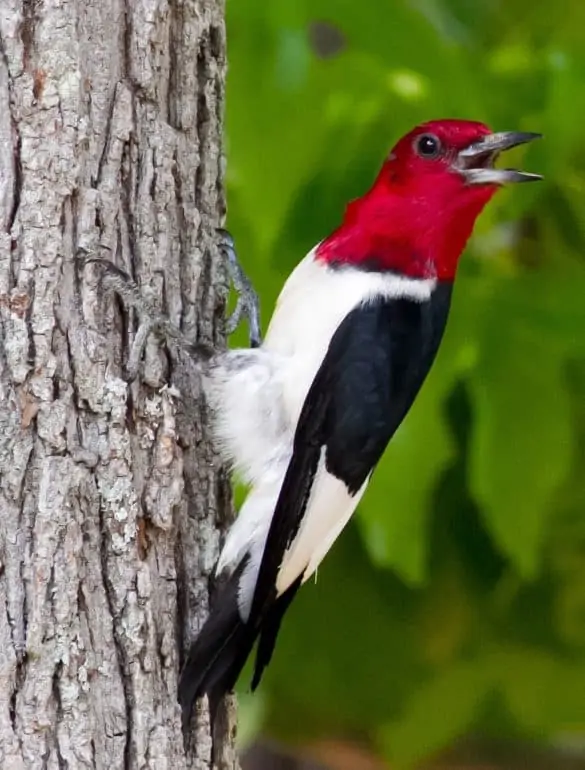
Size: 7-9 inches
Adults have a bright crimson head, black back, enormous white wing patches, and a white belly. Most woodpeckers have more intricate patterns than these massive patches of solid color.
Diet: They are known to store wood-boring insects and nuts in the autumn. Unlike many woodpeckers, they spend a lot of time perched and flying out to catch insects. Insects like grasshoppers have been discovered in cracks in wood and under roof shingles, where they’re stored!
Habitat: In beaver swamps, river bottoms, and swamps, open woodlands, pine plantations, standing wood.
Location: While uncommon in New England, it is more common in the eastern half of the US.
Nesting: Inside dead wood or dead branch cavities, 4-7 eggs are found.
INTERESTING FACTS ABOUT RED-HEADED WOODPECKERS
- Other woodpeckers or birds that approach their nest are frequently attacked by them. Other birds and even eggs from nearby nests are attacked by these woodpeckers, who are extremely territorial. Unfortunately, they are declining in many regions, especially the northeastern United States.
- When it comes to competing for nesting holes, they face the same issue as many birds. However, this species is unique in that it nests solely in dead trees, which are rapidly disappearing. To minimize fire danger, discourage certain blight insects, or simply for aesthetics, dead or dying trees are frequently removed from land for firewood.
2. PILEATED WOODPECKER

Size: The largest North American woodpecker is 16 to 19 inches long.
Identifying markings: Black with a red crest, black and white stripped face, a white stripe down the neck, and white wing linings. A crimson mustache adorns the males of this species.
Diet: Some berries, ants, and other wood-borers.
Habitat: The area is covered in mature woods with huge trees.
Location: Much of Canada’s northern half and the eastern half of the United States.
Nesting: Cavities excavated from dead trunks or limbs of live trees are used to deposit 3-8 eggs. Wood chips are used to line the cavity.
- These huge woodpeckers can create holes that are up to seven inches across. It’s a spectacle to see one go to work on a tree, with a spray of wood chips flying out like a stump grinder, if you’ve ever had the pleasure. They sometimes dig their holes so far into the tree that tiny trees are momentarily snapped in half on accident. Mature woods with ancient huge trees are preferred.
- When mature forests were chopped down to become farms in the early 18th and 19th centuries, much of their habitat was destroyed. The Pileated have made a comeback as farmlands and forests have grown in popularity, seeming to adapt to younger woods and trees.
3. RED-BELLIED WOODPECKER

Size: 8.5 to 10 inches is common for most breeds.
Identifying markings: Back is barred and speckled black and white, with a pale breast. Although you may not notice it unless they are in the proper position, they have a somewhat reddish belly that gives them their name. In males, the crimson cloak stretches from the beak to the neck, while in women, it simply extends down the nape of the neck.
Diet: Insects, fruit, and seeds are all common sources of infestation.
Habitat: Open woodlands, farmland, orchards, shadow trees, and parks. Likes deciduous trees and does well in the suburbs.
Location: The United States of America’s east coast Southern New England was overrun by them.
Nesting: 3-8 eggss are deposited in a dead tree limb or utility pole hole.
INTERESTING FACTS ABOUT RED-BELLIED WOODPECKERS
- Up to two inches beyond the tip of their beak, they may stick out their tongue! It is rather lengthy, and with a hard barb at the tip that they can use to spear grasshoppers and beetles, it is also quite pointy. Oranges have even been known to be punctured with this language and the pulp lapd out.
- In the winter, especially around bird feeders, red-bellied woodpeckers will dine on suet and seeds.
4. RED-COCKADED WOODPECKER
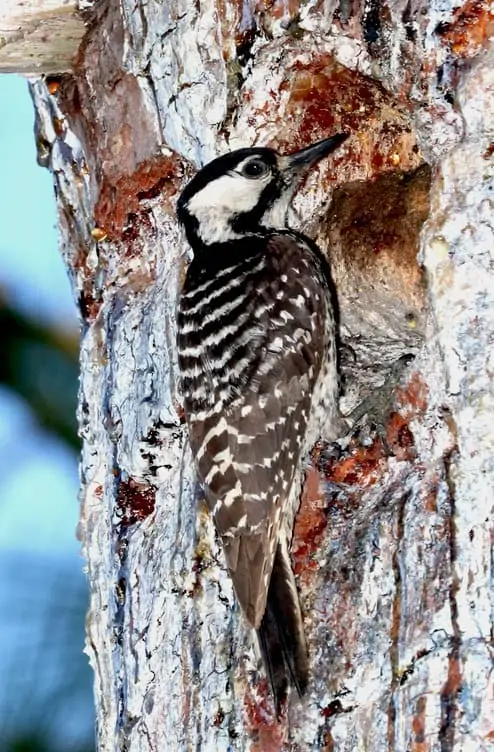
Size: 8-8.5 inches
Identifying markings: With a large white cheek and a barred back, this boldly patterned black and white dog stands out. Males have a crimson patch on the crown’s rear.
Diet: Wood-boring insects.
Location: The southeastern United States.
Nesting: In the decomposed heartwood of a living pine, 2-5 eggs are found. Nest cavities may be used for many years in loose colonies among stands of tall pines.
INTERESTING FACTS ABOUT RED-COCKADED WOODPECKERS
- Only open pine woodlands are home to this rare and unfortunate declining woodpecker. The pine trees with red-heart disease, a fungus that infects the heartwood and makes it easier for woodpeckers to remove and dig their elaborate nesting holes, are sought out by these unique woodpeckers. While most pine woodlands are cut before trees reach 70 years of age, red heart is a fairly frequent ailment of trees. The pine woodlands are becoming less open.
- Only four population groups of Red-cockaded woodpeckers are thought to exist in the world today, all of which are found in the southeastern United States. Since 1973, they have been designated as a threatened species.
5. FLICKERS
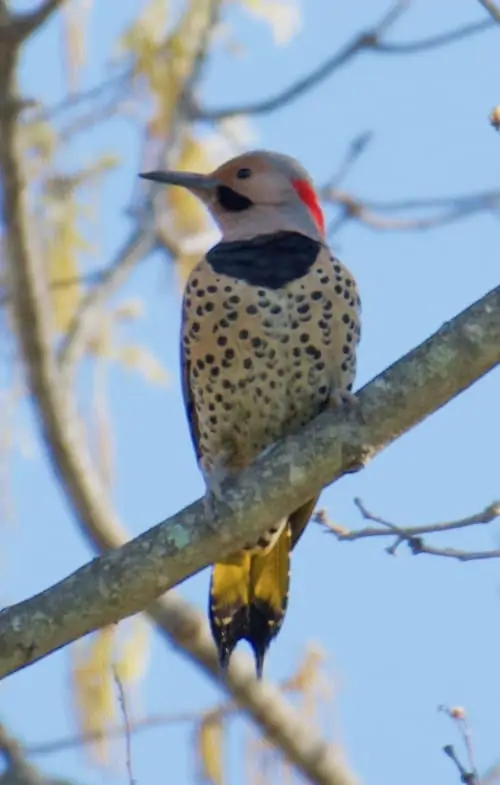
Size: 10-14 inches
Identifying markings: Large black crescent-shaped marking on the breast, with dark brown back and black spots on the belly. Depending on the subspecies, the underside of the wings is either yellow or red. (Yellow in the north and east, red in the south and west.) Females do not have a mustache on their face, whereas males do. It is black or red depending on the subspecies.
Diet: Ants, other insects, fruit, seeds, and nuts
Habitat: Forests, deserts, and suburbs are all part of the
Location: Throughout the United States, Northern Flickers Many sections of Mexico have been brought into Canada. Gilded Flicker can be found in southern Nevada, Arizona, and northern Mexico.
Nesting: In dry environments, 3-14 eggs are deposited in a hollow in a tree or cactus.
INTERESTING FACTS ABOUT FLICKERS
- Flickers come in three different subspecies. Yellow-shafted and red-shafted Northern Flickers are distinguished from each other. The east is home to the yellow-shafted, while the west is home to the red-shafted. Just in the southwestern United States, there’s a Golden Flicker. It lives in vast cactus plantations and is found in Mexico.
- One of the few woodpeckers that migrate to North America is the Northern Flickers. In the winter, birds in the northern part of their range will migrate farther south. Flickers are also fond of finding food on the ground, which is another interesting fact.
- Flickers dig in the earth to hunt for ants and then lap them up with their long tongue. In reality, they are said to eat more ants than any other North American bird!
6. SAPSUCKERS

Size: 8-9 inches
Diet: Sap, insects, berries.
Habitat: Forests, woodlands.
Nesting: Live tree cavities are used to deposit 4-7 eggs. Aspen trees are their favorite.
IDENTIFYING MARKINGS
Yellow-bellied: Above, a white wing patch with black and white. Males have a red crown and neck, while females have a white neck.
Red-naped: Other woodpeckers are separated from it by a bold white slash on their wings. It differs from the red-breasted sapsucker by having a bold black, white, and red face pattern on the back.
Red-breasted: A strong white stripe across the shoulder, with a mostly crimson head and breast. Just a little white mottling on the back.
Williamson’s: The face has two white stripes, a red throat, and a yellow belly. Males are generally black with a huge white wing patch. The back and wings of a female are black and white, with a yellow belly.
LOCATION
Yellow-bellied: Eastern half of the United States, as well as much of Canada and Mexico
Red-naped: Outside of the coast, Southern British Columbia stretches from the west coast of the United States to Mexico.
Red-breasted: Canada and the United States have a far western coast.
Williamson’s: South of the Rocky Mountain range, towards Mexico.
INTERESTING FACTS ABOUT SAPSUCKERS
- Yellow-bellied (mostly eastern), Red-naped (mostly western), Red-breasted (west coast exclusively), and Williamson’s sapsuckers are the four types found in North America.
- They don’t suck sap, they lick it with brush-like bristles that protrude from their tongue, which is what they’re called. They drill a tree’s trunk with rows of vertically and horizontally aligned holes. They’ll lick up the sap that has leaked out.
- Insects may be attracted to the sap, and if they are caught, the woodpeckers can devour them immediately after they are stunned.
7. DOWNY WOODPECKER

Size: The North American woodpeckers range from 6 to 7 inches in size.
Identifying markings: Short beak, black and white striped face, underparts pure white. Upper parts black and white with a large white vertical stripe down the middle of the back. A crimson nape patch is seen on males.
Diet: Insects, berries, and seeds that bore in wood.
Habitat: Open woodlands, orchards, and parks.
Location: Over the bulk of the United States, And in Canada and the United States
Nesting: 3-7 eggs are deposited in a cavity or birdhouse.
INTERESTING FACTS ABOUT DOWNY WOODPECKERS
- Most of the country is covered in Downy’s, and they’ll happily visit bird feeders for seeds and suet. My feeders are usually one of the first species to arrive when I move and set up my feeders.
- Hummingbird nectar is also frequently found on hummingbird feeders when they’re caught drinking it.
- Like other woodpeckers, Downy Woodpeckers drill into trees to extract insects and larvae from the bark crevices.
8. HAIRY WOODPECKER
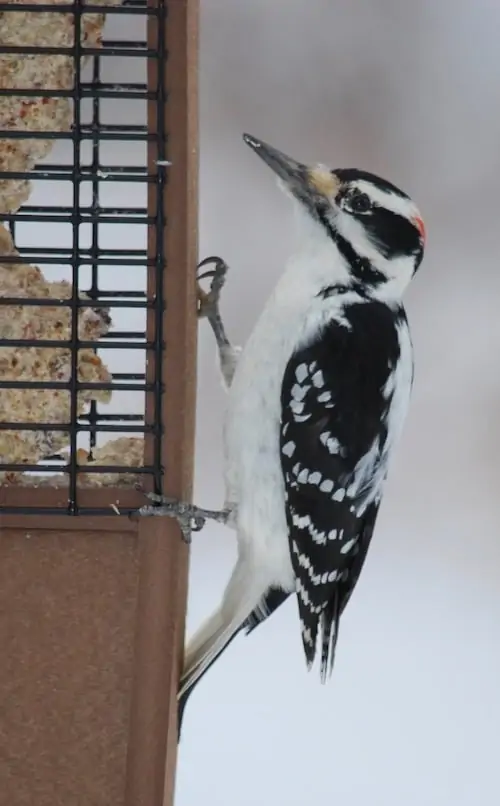
Size: 8.5-10 inches
Identifying markings: White stripe down the back, white wings with black spots, and all-white belly. A red patch on the nape of males indicates their sex.
Diet: Insects, berries, and seeds are among the wood-boring species.
Habitat: Orchards, parks, and mature forests.
Location: Over most of the United States, Some part of Mexico, as well as Canada.
Nesting: In a tree cavity, 3-6 eggs in a bed of wood chips.
INTERESTING FACTS ABOUT HAIRY WOODPECKERS
- The little Downy woodpecker looks a lot like Hairy. Their greater overall size, as well as the fact that their beak is longer, may help you spot them.
- They have been seen waiting for the Pileated Woodpeckers to finish boring a hole and then investigating and foraging for insects that the Pileated may have missed, according to researchers.
9. LEWIS’S WOODPECKER
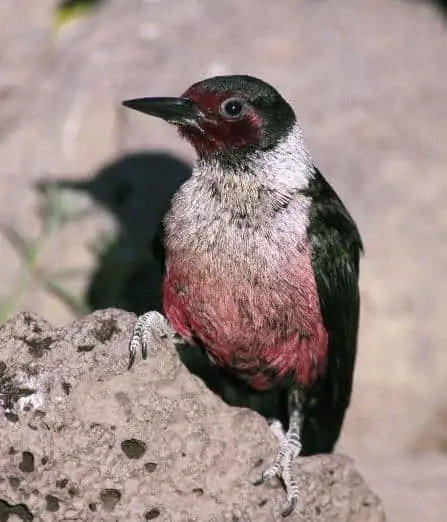
Size: 10-11 inches
Identifying markings: Dark green head and back, gray collar and breast, crimson face, pinkish belly. The wings are huge and rounded.
Diet: Bark-picked insects or those caught in flight. Wood chisels are seldom used. Berries and nuts are two sources of good nutrition. Acorns are stored in the cracks of trees, accounting for 1/3 of the diet.
Habitat: Open woodlands, trees, and scattered tree patches.
Location: Western U.S.
Nesting: Cavity in a dead branch or stump 5-9 eggs.
INTERESTING FACTS ABOUT LEWIS’S WOODPECKERS
- From their unusual coloring to their behavior, Lewis’ woodpeckers have a lot of unique qualities. Unlike other woodpeckers, they have a elegant, steady flight pattern that does not undulate.
- Other woodpeckers do not sit on wires and other perches in the open, unlike Lewis’s will.
- These social woodpeckers are most often found in family groups and are often seen.
- Meriweather Lewis, a half of the famed explorers Lewis & Clark, was named after this unusual woodpecker. This is the first report of this species, which chronicles their famous 1805 trek across the western United States.
10. ACORN WOODPECKER
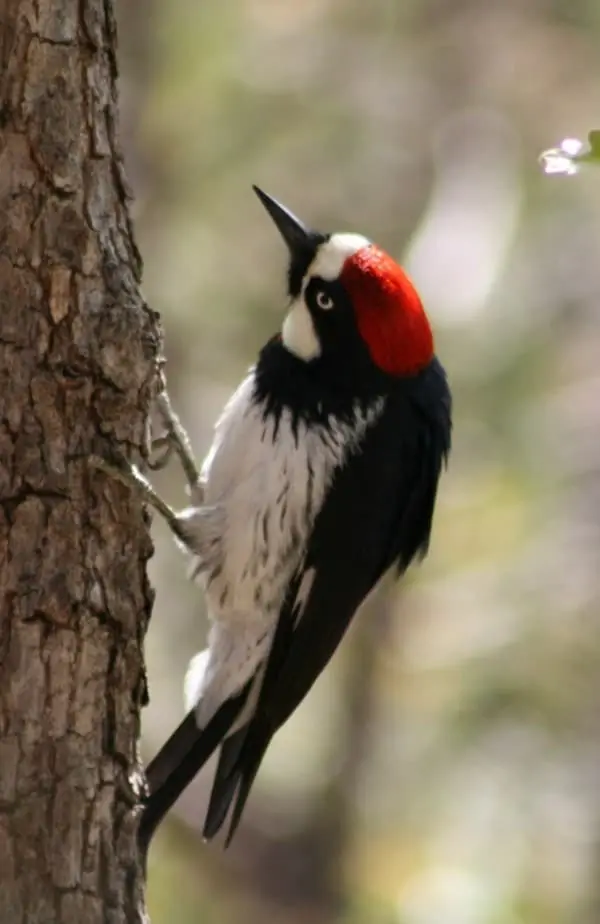
Size: 8-9.5 inches
Identifying markings: Yellowish forehead and neck, dark above with a red cap and black mask over the eyes. With a white rump and streaked chest, the glossy black all over.
Diet: Insects, fruit, and acorns are among the items on the menu.
Habitat: Woodlands, woods, and forested canyons.
Location: Swaths of the west coast of the United States go across Mexico and Central America.
Nesting: In a cavity under dead oak or other trees, 4-6 eggs are laid.
INTERESTING FACTS ABOUT ACORN WOODPECKERS
- Between 3 and 10 acorn woodpeckers live in a colony.
- Acorns, their winter food source, are gathered and stored as a group. For many months, the group is fed by stored acorns. They stuff the acorn into the hole they drill in a tree trunk.
- Nesting is another example of how the group works together, with all members of the group taking turns incubating eggs and feeding the young. Up to 50,000 acorns have been discovered in “granary trees.”

11. GILA WOODPECKER

Size: 8-9.5 inches
Identifying markings: Males have a red hat, and the back is barred black and white.
Diet: Insects, fruit, seeds, and lizards are among the animals found.
Habitat: Large cacti, arid subtropical woods, and woods characterize the deserts.
Location: North eastern Mexico and southern Arizona.
Nesting: 2-7 eggs in a cactus or tree cavity.
Interesting facts about Gila Woodpeckers
- Gila seldom stay in a nest hole excavated in a saguaro cactus for more than a few months. This allows the inner pulp to dry before forming sturdy, stable walls inside the space.
- According to the North American Breeding Bird Survey, Gila Woodpecker populations fell by 49% between 1966 and 2014. They are not yet classified as a concern species because their population is still high enough.
- The United States is home to about a third of the population. In Mexico, the percentage is 2/3. The Sonoran Desert’s human development is reducing their habitat. In addition, non-native European starlings fiercely compete for nesting holes with them.
12. THREE TOED WOODPECKER

Size: 8-9.5 inches
Identifying markings: Underparts white, flanks black and white, black back with a barred center. With a white eyebrow, black head. A yellow hat is worn by the male.
Diet: Insects, spiders, and berries are all examples of wood-boring insects.
Habitat: Coniferous forests.
Location: Along the Rocky Mountain corridor, it runs through much of Canada and Alaska.
Nesting: The wood chips or fibers used to line the tree cavity can contain 3-7 eggs.
INTERESTING FACTS ABOUT THREE-TOED WOODPECKERS
- The three-toed woodpecker is the only one that breeds as far north as upper Canada and Alaska.
- Four twos – two forward and two backward – are seen on most woodpeckers. This woodpecker, on the other hand, has three toes and they all point forward. Its name implies so.
- They prefer to flake off the bark with their bills instead of doing extensive drilling into trees to find their food. Typically, you’ll only find dead or dying trees.
13. BLACK-BACKED WOODPECKER

Size: 9.5-10 inches
Identifying markings: It is completely black in color back, wings, and tail. White underparts with black and white barring on the flanks. With a white whisker mark on the black head. The yellow hat worn by the male is distinctive.
Diet: Berry-eating spiders and wood-boring insects
Habitat: Coniferous forests.
Location: Some sections of north western United States and Canada are covered. Northern California and the Pacific Coast.
Nesting: 2-6 cavities, generally 15 feet or less from the ground.
INTERESTING FACTS ABOUT BLACK-BACKED WOODPECKERS
- The three-toed woodpeckers have a lot in common with these. They, too, have three toes on their front feet.
- Instead of drilling, they choose to flake bark off of trees. Black-back, on the other hand, favors burnt-over locations.
- In recently burnt habitats, they travel from spot to spot in search of outbreaks of wood-boring beetles.
- If a reduction in their preferred food source or an overabundance leads to a demographic boom and the need to find territory, they will go far south of their normal range, into the United States.
14. GOLDEN-FRONTED WOODPECKER

Size: 8.5-10 inches
Identifying markings: The gold markings above the beak and at the nape of the neck distinguish Golden Fronted Woodpeckers from other woodpeckers. Grayish tan underparts and a barred black and white back. The cap of the male is red.
Diet: Insects, fruit, and acorns are among the foods listed.
Habitat: mesquite, dry woodlands, and groves
Location: From central and southern Texas to the eastern side of Mexico,
Nesting: On the dead trunk limb of a tree or telephone poles, 4-7 eggs.
INTERESTING FACTS ABOUT GOLDEN FRONTED WOODPECKERS
- Telephone poles and fence posts are favorite nesting sites for these woodpeckers. Drilling into them so often may cause serious damage. They carve a 6-18 inch hole (sometimes even deeper) into the earth.
- During the Texas summers, some woodpeckers get purple stains on their faces from eating a diet of prickly pear cactus fruit.
15. LADDER-BACKED WOODPECKER
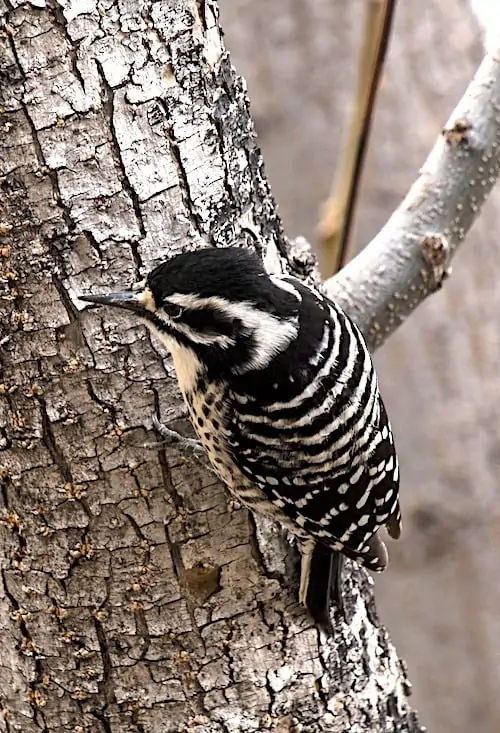
Size: 6.5-7.5 inches
Identifying markings: Males wear a red hat and have black and white barring on the pack, patterned flanks.
Diet: Caterpillars, cactus fruit, and wood-boring insects
Habitat: Arid, dry brushlands and thickets dominate the landscape. Desert is what it’s called.
Location: In the United States, very south-eastern is a prevalent term. Almost all of Mexico is covered by this.
Nesting: In the cavities of trees or cactus, 2-7 eggs are laid.
INTERESTING FACTS ABOUT LADDER-BACKED WOODPECKERS
- Texas is the most common state in the United States. Dry, arid environments are home to these woodpeckers.
- Their ability to detect wood-boring beetle larvae is well-known.
- They may be seen in various parts of the world, with just the enormous Seguaro cactus to hide them away.
- They were dubbed the “Cactus Woodpecker” for a reason. They easily negotiate the thorns and spines of cactus and mesquite because to their tiny size and agile motions.
- While their ranges barely overlap, the Nuttall’s woodpecker of California is the most closely related species to Ladder-backed Woodpeckers.
16. NUTALL’S WOODPECKER

Size: 6 – 7.5 inches
Identifying markings: The adult female has a black forehead, crown, and cap, while the adult male has a red crown and black forehead. They are distinguished by their black head, white throat, belly, black breast spots on their breast and rump. The Nuttall’s Woodpecker has a red crown that extends farther down its neck than the Ladder Backed, which is the only difference between them and the Ladder Backed.
Diet: Insects.
Habitat: From southern Oregon to northern Baja California, the western Cascade Mountains. Oak trees and streamsides
Location: California’s western half is mostly where you’ll find it.
Nesting: 3-6 eggs
INTERESTING FACTS ABOUT NUTALL’S WOODPECKERS
- Nuttall’s Woodpeckers do not eat acorns, despite the fact that they prefer to spend their time in oak woodlands. Beetles, beetle larvae, ants, and millipedes are the primary sources of food for them, along with blackberries.
- In their limited ranges, their populations are currently stable. Nevertheless, there is the possibility of future worry if the oak environment they occupy changes dramatically, since it is restricted in size. Sudden oak death, a fungus disease that kills oak trees, is the primary concern.
17. WHITE-HEADED WOODPECKER
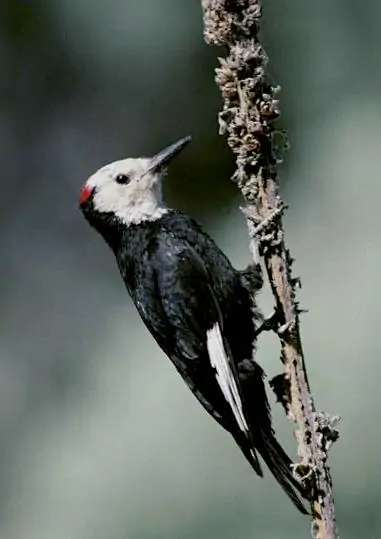
Size: 9-9.5 inches
Identifying markings: The majority of the body, wings, and tail are black. The crown and neck are both white, which is unusual. On the wing, there is a white patch. On the nape of the male, there is a little red patch.
Diet: Wood-boring insects and pine seeds
Habitat: Mountain pine forests are common in the region.
Location: In the Pacific Northwest of the United States, pockets of coniferous woods may be found.
Nesting: Prefer snags, stumps, and fallen trees for their 3-7 eggs in cavities.
INTERESTING FACTS ABOUT WHITE-HEADED WOODPECKERS
- Pinecone raiders, they’re pros. To avoid getting sap on their feathers, the white headed woodpecker will cling to the walls or bottom of an unopened pine cone. After that, they crack open the scales and clean out the seeds. They then hammer the seed to break it apart after they have taken it and wedged it into the gap between tree bark.
COMMON WOODPECKER CHARACTERISTICS
Let’s now explore the features and behaviors that woodpeckers share, as well as what makes them stand out from other types of birds, after we’ve examined the 17 sorts of woodpeckers found in North America.
WOODPECKERS ARE MADE FOR CLIMBING
Three toes point forwards, while one toe points backwards, in most songbirds, perching birds, and birds of prey. Two toes face front and two toes face rear is the most common arrangement in woodpeckers. Zygodactal refers to this arrangement.
They can walk up the trunks vertically and balance while hammering, thanks to their ability to grasp tree trunks with ease. Like a bicycle’s kickstand, their stiff tail feathers may offer extra support and stability.
Their feet are small and muscular, perfect for scrabbling on tree trunks, and their toes feature razor-sharp claws for grabbing bark. A thickened membrane covers the eyes of woodpeckers just before their beaks make contact with the wood, protecting them from flying wood chips and splinters.
WOODPECKERS HAVE VERY STRONG BILLS
For drumming on hard surfaces and boring holes into trees, woodpeckers have strong bills. These long, pointed beaks make it easier for them to dig channels in trees for nesting.
The pressure generated by the force of impact is absorbed by muscles at the base of the beak, which act as shock absorbers. To help filter out dust and tiny wood chips while hammering away, many woodpeckers have nostrils lined with bristles.
AND LONGUE TONGUES
Woodpeckers have a long, sticky tongue that they can use to catch insects inside the holes they’ve carved. They actually extend all the way around the woodpeckers’ skull, via a particular space. Several have a pointed barb on the end, which may help you “spear” prey.
WHAT DRUMMING IS AND WHY WOODPECKERS DO IT
Woodpeckers communicate through drumming. Males “drum” in the spring by beak drilling on hard surfaces, such as trees, metal gutters, house siding, utility poles, and trash bins. This is done to proclaim their territory and attract mates.
Drumming is a brief burst of steady, fast paced drills, so you can hear the difference in sound. It reminds me of a jackhammer. Pecking sounds will be spaced farther apart and more irregular while hunting for food or excavating holes.
MATING
The majority of species mate for a single season and collaborate to dig a nest hollow, raise their eggs, and discover food for their offspring. Throughout the night, males will often take over incubation, while females will do so during the day.
Hatching an egg takes around two weeks on average. In around a month, the young are ready to leave the nest, and until the end of the summer, they usually stay with their parents in family groups.
SPECIALIZATION
Several distinct species of woodpeckers may live in the same environment in certain geographic regions. If each species has its own niche and there is minimal competition for food or reproduction resources, this is potential.
Littleer woodpeckers, for example, may pick insects from the bark’s crevices, whereas bigger species may bore into the tree itself to get them. Downy and Hairy woodpeckers are frequently seen living in the same locations because they don’t take their food from the same source.
WOODPECKERS ARE AN IMPORTANT PART OF THE ECOSYSTEM
As part of the ecosystem, woodpeckers play critical roles. They may aid in the management of insect populations and forest upkeep. When populations of wood-boring insects get out of hand, they can destroy entire pieces of forest. Beetles, as well as their larvae, will be eaten by woodpeckers. They may reduce a single tree’s infestation by up to 60%!
Many birds and animals utilize old woodpecker holes, including the Cooper’s hawk. Sparrows, wrens, bluebirds, nuthatches, and kestrels require nesting cavities but cannot build them on their own. Flying squirrels and mice, for example, will utilize these holes for protection.
HOW DO WOODPECKERS SURVIVE ALL THAT HEAD-BANGING?
You may be curious about how woodpeckers can pound their heads into trees without mushrooming their brains. Woodpeckers have peculiar physical characteristics to defend their brains, as one would anticipate.
While not going into too much detail regarding the numerous systems at work, here are a few of the elements that go into allowing them to drill;
- The brain is small and smooth.
- The subdural space is narrow in this case.
- To prevent the brain from moving back and forth, there is little cerebrospinal fluid in the skull.
- Plate-like bones in the skull help to preserve it and limit injury.
- Every time the bird pecks, it acts as a seat-belt for the skull, thanks to the hyoid bone wrapped around it.
- The bill’s upper section is somewhat bigger than its lower section. The impact energy is dispersed thanks to this “overbite” and the materials that make up the beak.
The impact energy in a woodpecker’s body is transformed to “strain energy” when it hits a tree. The strain energy is redirected into the body rather than the head by the woodpecker’s specialized anatomy, which only retains .3% of it.
The heat dissipates the little quantity in the skull. As a result, the woodpeckers’ skulls heat up quickly during this process, which protects their brains. To beat the heat, woodpeckers take frequent rests in-between pecking.
In order to better understand how it functions and future technologies for things like helmets and automobiles, scientists are still studying woodpeckers’ shock absorption and energy conversion methods.
